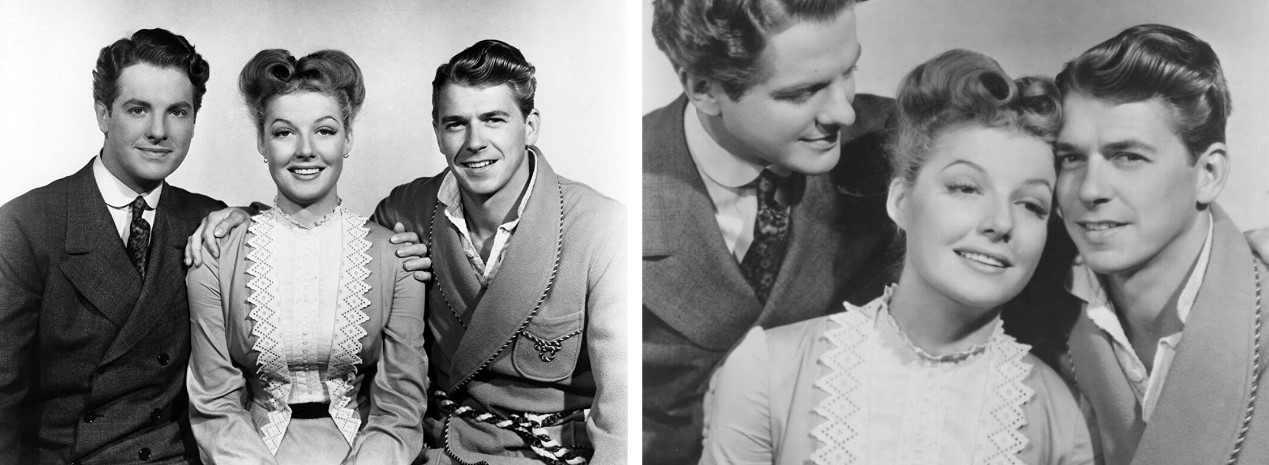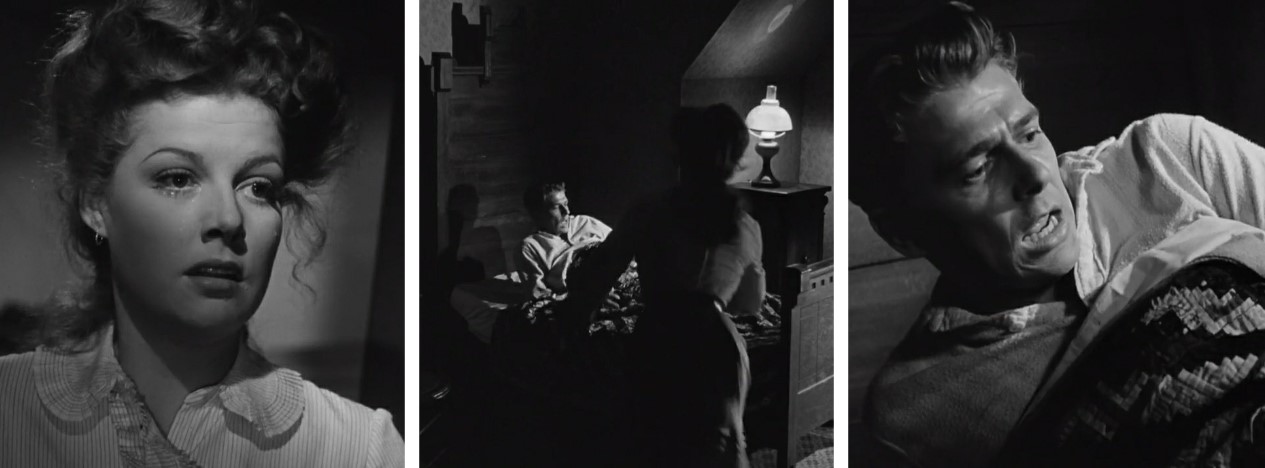In movieland, the month of February is almost entirely dedicated to the Academy Awards, the industry's oldest and most prestigious awards ceremony. In anticipation to the 89th Oscars on February 26, every «Film Friday» this month will be about a Best Picture winner or nominee. This particular one also serves to honour Ronald Reagan's 116th birthday, which is next Monday. According to most critics, this is the best of his films.
Directed by Sam Wood, Kings Row (1942) tells the story of five young people living in the small Midwestern town of Kings Row in the late 19th century. They are: Parris Mitchell (Robert Cummings), a medical student who lives with his grandmother; Cassandra Tower (Betty Field), the misunderstood daughter of Dr. Alexander Tower (Claude Rains); Drake McHugh (Ronald Reagan), a wealthy and fun-loving orphan; Louise Gordon (Nancy Coleman), the daughter of the sadistic town physician, Dr. Henry Gordon (Charles Coburn); and Randy Monaghan (Ann Sheridan), a tomboy whose father (Ernest Cossart) is a railroad worker. When Dr. Tower learns of Cassandra's romance with Parris, he locks her away. As for Drake, he intends to marry Louise despite the disapproval of her father, but she does not have the strength to defy her parents.
After the death of his grandmother, Parris decides to move to Vienna to study psychiatry and asks Cassie to marry him. She initially resists, running away, but later comes to beg him to take her with him. The next day, Parris finds out that Dr. Tower poisoned his daughter and then shot himself, wanting to prevent Cassie from going insane like her mother. While Paris is in Vienna, Drake's trust fund is stolen by a dishonest bank official and he is forced to work locally for the railroad. When he is accidentally crushed by a boxcar, Dr. Gordon is called to treat him. Gordon's hatred of Drake prompts him to amputate both of his legs needlessly.
Meanwhile, Parris receives news of the events and, after Randy and Drake marry, he offers them money to start over. Later, Parris takes a leave of absence from his studies to visit Kings Row and decides to remain there when he learns that because of Gordon's death, the town needs a doctor. At Mrs. Gordon's request, he visits Louise, who has not left her room since Drake's marriage. Louise reveals that her father amputated Drake's legs because he believed it was his duty to punish wickedness. At first, Parris wants to keep the truth from Drake, fearing it will destroy his fragile recovery, but then he decides to confront him with the facts. Unexpectedly, Drake reacts with laughter and defiance, and is finally able to accept his life.
DRAKE McHUGH (Ronald Reagan): Randy, where's the rest of me?
While leading a successful career as a music teacher at several educational institutions, Henry Bellamann was encouraged by his wife to pursue his interest in the literary world. His first published work was a book of poetry entitled A Music Teacher's Notebook, released in 1920. Six years later, he made his debut as a novelist with Petenera's Daughter, the story of a woman who falls in love with a farmer who deserts her when she becomes pregnant. There followed Crescendo in 1928, The Richest Woman in Town in 1932 and The Gray Man Walks in 1938.
It was only in 1940, with the release of Kings Row, that Bellamann finally found money and fame as a novelist. Set in the late 19th century, the book followed Parris Mitchell and his best friend Drake McHugh as they struggle to conform to the intolerance and hypocrisy of a small town in the American Midwest. By dealing with such controversial themes as mental illness, incest, homosexuality and suicide, Kings Row debunked the myth of the Midwestern small town as a place that fosters goodness, peace and harmony in its residents.
 |
| LEFT: Henry Bellaman, author of Kings Row, in 1905. RIGHT: First edition of Kings Row issued by the Council of Books in Wartime in 1944. |
Soon after the publication of Kings Row, 20th Century Fox sought to buy the novel as a vehicle for Henry Fonda, whose career had gained momentum following an acclaimed, Oscar-nominated performance in The Grapes of Wrath (1940). Eventually, however, the rights were purchased for $35,000 by Warner Bros., which then promptly refused David O. Selznick's offer of $75,000 to sell them to him. Warners head of production, Hal B. Wallis, tried to engage Wolfgang Reinhardt as producer of Kings Row, but he turned it down, arguing that the material «is for the most part either censurable or too gruesome and depressing to be used.» Wallis ended up producing the film himself, while veteran Sam Wood was hired as director.
A former real estate broker, Wood began his Hollywood career as an actor, before finding work as an assistant director to Cecil B. DeMille. In 1919, he made the full transition to directing, first at Paramount and later at Metro-Goldwyn-Mayer, where he would make most of his films. By the time he signed on to helm Kings Row, Wood had already scored two consecutive Academy Award nominations for Best Director, for Goodbye, Mr. Chips (1939) and Kitty Foyle (1940).
 |
| Sam Wood filming a scene in Kings Row with Ronald Reagan and Ann Sheridan. |
Wallis originally envisioned the character of Paris Mitchell being played by Tyrone Power, who expressed his interest in starring in the film. When Darryl F. Zanuck, head of production at Fox, refused to loan Power, Wallis decided to borrow Robert Cummings from Universal instead. After years of small roles in B pictures, Cummings had recently reached stardom as Jean Arthur's love interest in the comedy The Devil and Miss Jones (1941), directed by Wood for RKO.
Many actresses were considered for the role of Cassie Tower, including Katharine Hepburn, Ginger Rogers, Olivia de Havilland, Gene Tierney, Priscilla Lane and Ida Lupino. Wood pushed hard to cast Lupino, saying that she «has a natural something that Cassie should have,» but she turned it down, as did Rogers and de Havilland. Warner Bros. reigning queen Bette Davis then began lobbying for the part, but the studio was against her casting, believing that she would dominate the picture. Davis then suggested Betty Field, who had established herself as a dramatic actress in the Best Picture nominee Of Mice and Men (1939).
 |
| LEFT: Betty Field and Robert Cummings. MIDDLE: Ann Sheridan, Ronald Reagan and Robert Cummings. RIGHT: Robert Cummings and Ronald Reagan. |
Although John Garfield, Dennis Morgan, Eddie Albert and Franchot Tone were originally considered to play Drake McHugh, the part was eventually assigned to Ronald Reagan. A graduate of Eureka College, Reagan began his professional career as a sports announcer at several radio stations. In 1937, while travelling with the Chicago Cubs in California, he took a screen test that materialised in contract with Warner Bros., where he would make the majority of his films. Making his screen debut in Love Is On the Air (1937), Reagan appeared in 19 pictures before the decade was over, notably Dark Victory (1939) with Bette Davis and Humphrey Bogart. His performances in Knute Rockne, All American (1940) and Santa Fe Trail (1940) led to his being voted the fifth most popular young star in Hollywood in 1941.
Reagan initially struggled with the scene in which his character cries out in horror after realizing that both of his legs have been amputated. «I felt I had neither the experience nor the talent to fake it,» he recalled. «I simply had to find out how it really felt.» He rehearsed repeatedly by himself, consulting several physicians and psychiatrists, and even talking with disabled people. In the end, he shot the scene in one take, with no rehearsal. Reagan later used his iconic line, «Where's the rest of me?», as the title of his autobiography, published in 1965.
 |
| Robert Cummings, Ann Sheridan and Ronald Reagan in publicity stills for Kings Row. |
Due to its controversial themes, screenwriter Casey Robinson believed Kings Row would not be approved by Joseph Breen, head of the Production Code Administration. In a letter to Wallis, Breen wrote, «To attempt to translate such a story to the screen, even though it be re-written to conform to the provisions of the Production Code is [...] a very questionable undertaking from the standpoint of the good and welfare of this industry.» The censor strongly objected to the portrayal «illicit sexual relationships» and to «the general suggestion of loose sex.» He also expressed concern about the characterization of Cassandra Tower, who is a victim of incest with her father in the novel, and the «sadistic» depiction of Dr. Gordon.
To resolve these issues, Wallis and Robinson met with Breen and the producer made it clear that the film «illustrate how a doctor could relieve the internal destruction of a stricken community.» Breen said that his office would approve the project if all references to incest, nymphomania, euthanasia and homosexuality, all of which had been suggested in the novel, be removed. In addition, all references to nude bathing were to be eliminated, as well as the suggestion of a «sex affair» between Randy and Drake. After several drafts of the script were rejected, Robinson was able to satisfy Breen and he finally gave his approval.
Kings Row was released on February 2, 1942 to generally positive reviews from critics. James Agee, the esteemed film critic who then wrote for TIME magazine, called Wood's screen interpretation of the Bellamann's novel «potent, artful cinema.» It was also a great financial success, earning $2,350,000 at the box-office that year. At the 15th Academy Awards ceremony held at the Cocoanut Grove in Los Angeles on March 4, 1943, the film received nominations for Best Picture, Best Director and Best Cinematography (Black-and-White).
Reagan was universally praised for his performance as Drake McHugh, which Philip Harting in Commonweal called «splendid.» For the actor, the only downside to this film that brought him to the brink of stardom was its timing. Kings Row was filmed in 1941, the year the Japanese attacked Pearl Harbor and plunged the United States into World War II. It was released in 1942, when Reagan was in the Army. His agent, Lew Wasserman, negotiated for him a new million-dollar seven-year contract with Warner Bros. on the strength of his work in Kings Row, but Reagan's military service deprived him of the opportunity to take advantage of his breakthrough role and other rising stars eclipsed him during the war years. This led to a series of post-war conflicts with Warners, which preferred him in light comedies rather than in the dramatic roles he thought his performance in Kings Row had earned him. Reagan and most film critics have always considered Kings Row his best performance as an actor.
______________________________________________
SOURCES: City of Nets: A Portrait of Hollywood in the 1940s by Otto Friedrich (University of California Press, 1986)
Dictionary of Midwestern Literature, Volume One: The Authors edited by Philip A. Greasley (Indiana University Press, 2001)
Dictionary of Missouri Biography edited by L. O. Christensen, W. E. Foley, G. R. Kremer and K. H. Winn (University of Missouri Press, 1999)
Govern Reagan: His Rise to Power by Lou Cannon (Public Affairs, 2009)





Comments
Post a Comment